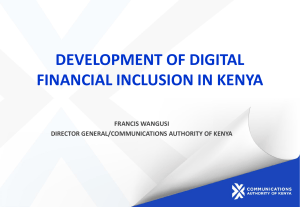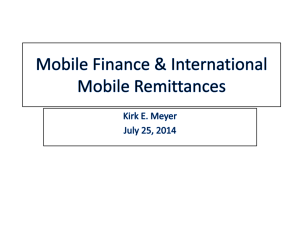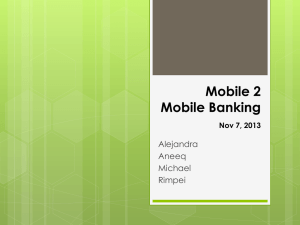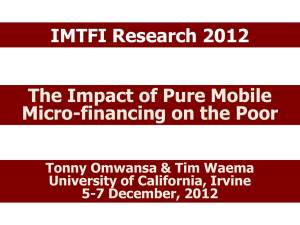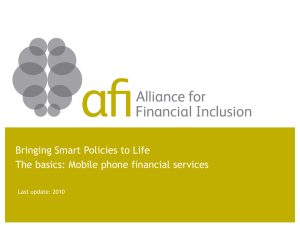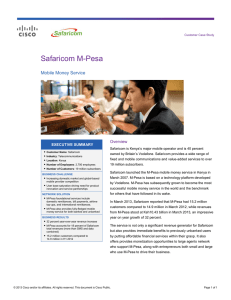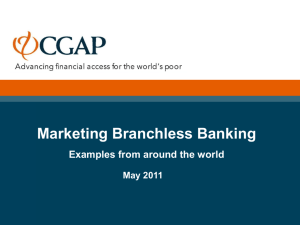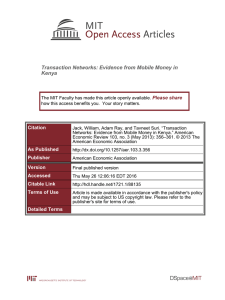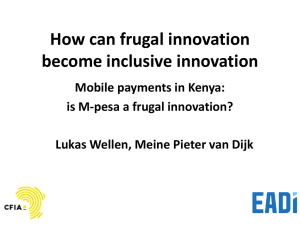PowerPoint Presentation - Slide 1
advertisement
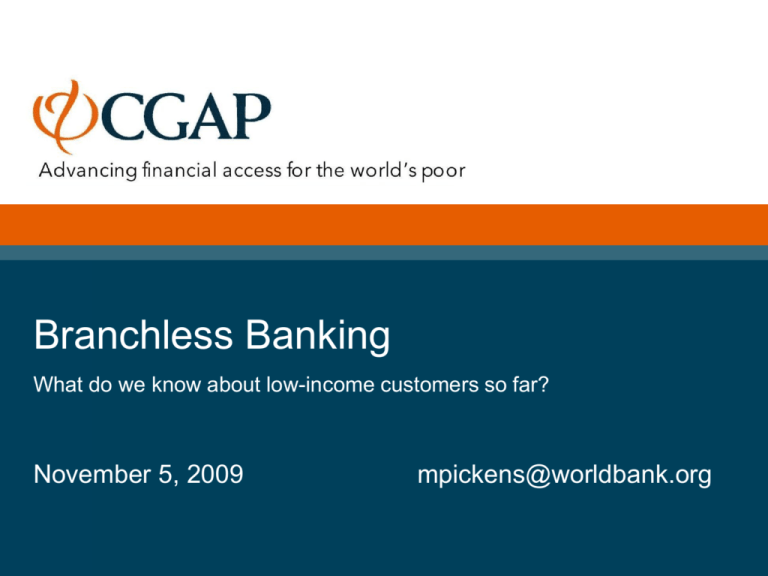
Branchless Banking What do we know about low-income customers so far? November 5, 2009 mpickens@worldbank.org CGAP: Who we are • Independent research and policy center dedicated to advancing financial access for the poor • Founded 1995 • Supported by 33 funders • Housed at World Bank • Three major fronts – Government and policy – Market intelligence – Market infrastructure CGAP Technology Program Instigate GXI - Philippines Eko - India Orange –W. Africa NLink - Philippines Equity- Kenya AVV/DDD-Colombia WIZZIT – S. Africa A B New Exp - Kenya Xac - Mongolia RFR - Ecuador TN/Tameer-Pakistan SERP - India NewBank - Brazil MMA - Maldives Demystify • How will low-income people respond? • Which business models are viable? • What does enabling regulation look like? Share • Clinton Global Initiative, Mobile World Congress • Wired, The Economist, CNN.com, The Banker • Top-rated blog on tech and banking the poor • Focus notes & briefs 2 Branchless Banking: getting big Clients in implementations reaching the unbanked 154.7 mil 180 160 140 120 100 80 60 40 20 0 1999 2000 2001 2002 2003 2004 2005 2006 2007 2008 2009 Source: CGAP analysis based on provider interviews Attractive… but how many success stories? Throughput: US$ 1000 / year Item Value Fee 1% (USD 10) Capture 25% (USD 2.5) Active M-PESA 5.25 million Revenue (M-PESA) USD 13.1 mil Collins, Morduch, Rutherford & Ruthven. Portfolios of the Poor. 2009 Pop. India/Kenya 34.38 / 1 Revenue (scaled to India) USD 451.2 mil CGAP analysis, FSD Kenya, World Development Indicators database A familiar sight by now… Growing body of data about poor users 5 surveys, 4 countries, 8 providers, 5657 respondents Country Year CGAP’s Partner Respondents Service Method South Africa 2006 N/a 515 users and nonusers, LSM 5 or less WIZZIT Telephonic and in-person 51 minute survey Brazil 2006 N/a 750 users and nonusers with p.c. income <50% of min. wage Multiple banks Intercept with 45 minute survey Kenya 2007-08 Univ. of Edinburgh 350 users in lowincome communities M-PESA Semistructured interviews Kenya 2008 FSD Kenya, MIT 3,000 users and nonusers, all income levels M-PESA In-person 1.5 hr survey Philippines 2009 GSMA, McKinsey 1042 unbanked mobile money users in C-D-E consumer segments GCash Smart Money In-household, 120 question survey M-PESA metrics M-PESA through Oct. 2009 • Launched Mar. 2007 • 7.5 mil registered users • 12,000 agents • Handling US$ 600 mil/mo • 41% of the population “banked” Sources: Safaricom, FSD Kenya Sending Money Home: then and now Method 2007 2009 Hand 58 32 Bus 27 9 Post 24 3 M-PESA 0 47 What do clients say about M-PESA? Less convenient 4% Slower 2% Speed Convenience Quicker 98% More convenient 96% More expensive 4% Cost Source: FSD Kenya (2009) Cheaper 96% Less safe 2% Safety Safer 98% Effect of losing M-PESA None 2% Positive 2% Small negative 12% Large negative 84% Source: FSD Kenya (2009) How often money sent but not received? 8x lower incidence of loss Over last five Last years transaction M-PESA users 7.16% 0.03% Non-users 6.99% 0.24% Source: FSD Kenya (2009) Yet 20% report difficulty withdrawing funds No ID 7% Other 5% Safaricom network down 11% Agent system down 8% Agent had no money 69% M-PESA’s success points at what’s next Extremely high satisfaction rates • 85% “happy”, “very happy” or “extremely happy” • Remittance value up 5-30% So what… Clearly possible to gain traction with low-income clients over mobile Very focused on the advertised use • 85% use it 1x / month or less • Mostly on money transfer to family Sub-segment of “rebellious” users • 21% use M-PESA to store funds Much of the payments space still wide open Clear demand for more than what M-PESA offers Some surprises • 30% of customers are unbanked • 20% report problems with agents Is that a bad thing? Merchants have problems with adequate cash Source: FSD Kenya (2009); Morawczysnki & Pickens (2009) Heat loss on the way to adoption • 2/3 of low-income unbanked Filipinos aware of at least one mobile money product • Half understand the utility of mobile money services • 75% think mobile money would be easy to use • Yet 1/4 to 2/5 think mobile money is a “product for people like me” • Only 13% of low-income, unbanked Filipinos say they are interested in trying mobile money Source: Pickens (2009) What would make them adopt? Referral by a trusted source • Family and friends was the most common way users said they learned about mobile money (66%). • Nonusers with friends or family who use mobile money were 63 percent more likely to say mobile money is a product “for people like me” • Tangible goods drive benefit as well as “no-loss” guarantees Source: Pickens (2009) Savings looks like an adoption driver Savings attractive to some clients • 1 in 10 unbanked mobile money users stores an average of USD 31 in their mobile wallet (reported as 1/4 of household savings). • Savings most popular add-on product customers say they may use Source: Pickens (2009) Conclusions 1. Branchless banking is reaching the poor and unbanked 2. But also attractive to large numbers of the underbanked 3. Primarily used in very narrow ways, particularly sending money to friends and family 4. Some rebellious users point at other use cases (savings, credit, B2B) 5. Uptake driven by quality of competition Questions 1. How do branchless banking products compare against the informal? 2. Why do clients tolerate problems accessing cash with some branchless banking services? 3. What do we know about user interfaces that could make BB more accessible? 4. Are there exploitable links to social networking? 5. Who’s being left behind? Advancing financial access for the world’s poor www.cgap.org www.microfinancegateway.org Poor people have poor products Key values of mobile are “proximity” + “reliability” Deshpande, R. “Safe and Accessible” CGAP Focus Note 37. Different customers, different behavior, different profits Estimated profitability of mobile money accounts at a major Indian bank Student Salaried Average Tx /Mo Average Balance 500 1,000 1,500 2,000 2,500 3,000 3,500 4,000 4,500 5,000 5,500 1 -4 -2 0 3 5 7 10 12 14 17 19 2 -9 -7 -5 -2 0 2 5 7 9 12 14 3 -14 -12 -10 -7 -5 -3 0 2 4 7 9 4 -19 -17 -15 -12 -10 -8 -5 -3 -1 2 4 5 -24 -22 -20 -17 -15 -13 -10 -8 -6 -3 -1 6 -29 -27 -25 -22 -20 -18 -15 -13 -11 -8 -6 7 -34 -32 -30 -27 -25 -23 -20 -18 -16 -13 -11 8 -39 -37 -35 -32 -30 -28 -25 -23 -21 -18 -16 Self- 9 -44 -42 -40 -37 -35 -33 -30 -28 -26 -23 10 -49 -47 -45 -42 -40 -38 -35 -33 -31 -28 Calculated on variable-cost basis) Rupees/ Month /Account Source: CGAP analysis Small Business Employed -21 -26 What else do we know about branchless banking clients? 2 studies of M-PESA clients – 85% “happy”, “very happy” or “extremely happy” – 85% use it 1x / month or less – Remittance value up 5-30% – 30% unbanked – 21% use M-PESA to store funds – 20% report problems with agents FSD Kenya (2009); Morawczysnki & Pickens (2009) So what is M-PESA? – A money transfer service? – A transactional account? – A national payment system? M-Pesa generates 4.3x gross revenue than airtime Daily commission (left axis, in USD) 20 Mean = 86 transactions, $16.1 commission 16 12 -1 stdev = 54 transactions, $10.7 commission +1 stdev = 118 transactions, $21.6 commission 4.3x Airtime commissions 8 4 M-PESA commissions Stdev = 32 transactions (at the mean) 0 Number of transactions per day Probability distribution of no. of transactions Assumptions: Agent transaction volumes abased on average transactions observed in selected agents. Commissions are after-tax, and assume: (i) equal number of deposits and withdrawals, and (ii) agent pays 30% of commissions to aggregator. Exchange rate used is 79 KSh/USD. M-PESA vs. Airtime M-PESA vs Airtime (USD): 19 agents representing 125 M-PESA shops Airtime Capital M-PESA 129 1,605 Gross revenue 3.77 16.11 # trans / day 163 87 Avg ticket size 0.46 16.95 M-PESA vs Airtime: REVENUE Margin EXPENSE 5.0% 1.1% 2.22 11.10 - 3.82 Space (rent + util) 0.73 0.73 Wages 1.21 1.21 Taxes - 3.38 Cost of capital 0.28 1.95 PROFIT 1.55 5.01 ROI 373% Liquidity mgmt 97% • Amount of K needed to finance an agent business is 12x greater (equal to Kenya’s GDP per capita of US 1600) • Cost to maintain liquidity is #1 expense (30% of total expenses) • Although margin (1%) is lower than airtime (5%), agents are not fixated on the differential. • Profit from M-PESA (USD 5.01 / day) is 3.2x greater than selling airtime Worst Case: Japhet - Musoli $8 $6 Airtime $1.9 } Profit: $2.70 M-PESA unprofitable: Other $1.3 $4 Flour $0.4 Sugar $0.9 $2 Space $0.5 Taxes $0.4 Staff $1.2 Cooking Oil $0.8 M-PESA $1.8 Liquidity $2.2 $0 REVENUE COST • Revenue from M-PESA = $1.80 • Cost of M-PESA = $2.20 • Liquidity management is 50% of his total expenses due to long distance to exchange cash and e-float
